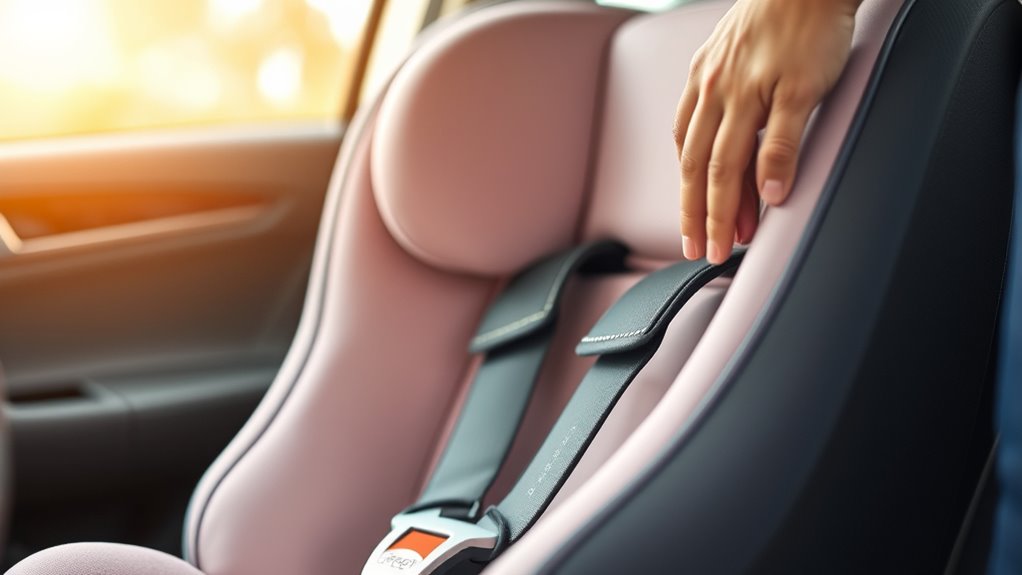Baby car seats are vital for keeping your child safe on the road, especially with new safety standards rising. These updated regulations emphasize features like side impact protection and improved harness systems. Starting December 5, 2024, the minimum weight for forward-facing seats will increase, ensuring even better safety. Following the latest guidelines and installation tips is crucial for compliance and protection. Stick with us to discover further details about the changes and how they impact your choices.
Key Takeaways
- Upcoming changes will raise the minimum weight for forward-facing seats to 26.5 lbs effective December 5, 2024.
- New side impact standards will apply to seats rated up to 40 lbs or 43.3″ starting June 30, 2025.
- Enhanced safety features include improved harness systems and side impact protection for better child safety.
- Compliance with updated standards ensures both safety and adherence to legal requirements for child restraints.
- Parents should stay informed about safety updates when purchasing new car seats to ensure optimal protection.

When it comes to child safety on the road, baby car seats are essential. You’ve probably heard that car seats can significantly reduce the risk of death in crashes—by 71% for infants under one year and 54% for toddlers aged one to four. Understanding the different types of car seats available can help you choose the right one for your child’s growth stages. Rear-facing, forward-facing, convertible, all-in-one, and booster seats each serve distinct purposes, ensuring your child’s safety as they grow.
Baby car seats are crucial for child safety, reducing crash fatalities by up to 71% for infants and 54% for toddlers.
It’s crucial that you install these seats correctly, as many parents misuse them due to improper installation or restraint techniques. Always follow the specific weight and height limits outlined by the manufacturer, and pay attention to your state’s legal requirements regarding child restraints. Laws can vary, so knowing what’s required for your child’s age, weight, and height will keep you compliant and, most importantly, keep your child safe.
Recent updates to safety features have raised the bar for baby car seats. Harness systems now feature snug straps with chest clips positioned at armpit level, which help secure your child effectively. New regulations also emphasize side impact protection, ensuring children are safe from various crash scenarios.
The National Highway Traffic Safety Administration (NHTSA) has improved crash test benches to reflect updated vehicle designs, which means that car seats are tested under more realistic conditions than ever before.
If you’re looking for a new car seat, be aware that weight limit changes are coming. Starting December 5, 2024, the minimum weight for forward-facing seats will rise to 26.5 lbs, and side impact standards will be enforced for seats rated up to 40 lbs or 43.3″ beginning June 30, 2025. These changes reflect a commitment to enhancing child safety on the road.
When installing a car seat, remember that rear-facing seats should be secured with harnesses positioned at or below shoulder level, while forward-facing seats require the seat belt to be locked and tightened. Always avoid placing a rear-facing seat in front of an active airbag. If you’re unsure about installation, don’t hesitate to seek professional assistance.
Choosing the right seat based on your child’s age and size is essential. Convertible and all-in-one seats offer flexibility for growing children, while booster seats ensure that older kids are safely positioned with the seat belt.
Frequently Asked Questions
What Is the Best Age to Transition From a Rear-Facing Seat?
The best age to transition from a rear-facing seat is when your child reaches the seat’s maximum height or weight limit, which varies by manufacturer.
Typically, this happens around two years old, but it depends on your child’s size.
Following the American Academy of Pediatrics guidelines, keep your child rear-facing as long as possible for safety.
Always check your seat’s specifications and state laws to ensure compliance with safety standards.
How Often Should I Replace My Baby Car Seat?
Think of your baby car seat like a trusty old friend; it needs to be replaced every five to six years.
Check the expiration date on the bottom or back, and if you’ve been in an accident, even a minor one, it’s time for a new one.
Always register your seat to stay updated on recalls.
Hand-me-downs can be risky, so it’s best to choose a seat that’s safe and reliable.
Can I Use a Second-Hand Baby Car Seat Safely?
You can use a second-hand baby car seat safely, but it’s crucial to verify its history.
Ensure it hasn’t been in a crash, check for recalls, and confirm it’s within the expiration date.
Look for complete original parts and obtain it from a trustworthy source.
If you can’t confirm these details, it’s better to invest in a new seat.
Your baby’s safety should always come first, so don’t take unnecessary risks.
What Are the Signs of a Car Seat Being Expired?
You can spot a car seat’s expiration by looking for several key signs.
Check for cracked shells, frayed straps, or missing parts, which indicate it’s no longer safe. If you notice rust on metal components or worn buckles, it’s time for a replacement.
Also, keep an eye out for any visible wear and tear that affects functionality. Regularly inspect your car seat to ensure it meets safety standards and remains reliable for your child.
Do Different States Have Varying Car Seat Laws?
Yes, different states have varying car seat laws.
You’ll find that regulations can differ significantly, especially regarding age, weight, and height requirements for car seats. For instance, some states require rear-facing seats until age two, while others mandate them only until age one.
It’s essential to know your state’s laws and any states you might travel to, ensuring your child’s safety and compliance with local regulations. Always double-check the specific requirements!
Conclusion
As you buckle your little one into their car seat, remember that your choice matters. With nearly 600 children under age 12 injured every day in car accidents, ensuring your baby’s safety is crucial. New safety standards are continuously evolving, providing you with better protection options. By staying informed and choosing the right car seat, you’re not just following the rules; you’re making a loving choice for your child’s future. Safety starts with you.









